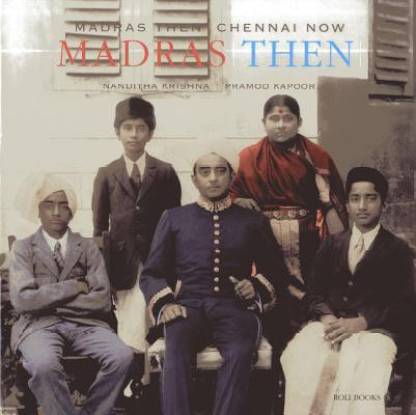A journey through the city’s changing fortunes.
http://www.nandithakrishna.in/images/360_Degree_view_of_Changing_City.pdf
Review by Timeri N Murari, India Today, April 9, 2014

To emphasise the past from the present, the book has two covers, depending on which period the reader wants to explore first. It’s a bit of a wrestle as you turn it over to start again from the back. Or the front. Whichever, it is a beautifully produced book, with both photographs and paintings.The Then is quite magical, richer too in the wide choice that goes back to the days of the sailing ships anchored off Fort Saint George. There’s a painting by Jan Van Ryne from 1754, an imaginative rendition of the fort, considering the artist also included Saint Thomas Mount, impossible to see from shore. What makes it different from other books on the city is the scope of the artwork. Nanditha Krishna has drawn on the archives of the British Library, The Royal Geographic Society, Getty Images and many a private collector. She has researched and written detailed notes on every image.

Gemini Ganesan and Kamal Haasan in the Tamil film Parthal Pasi The Erum (1962)
As there were no cameras to capture the brilliant colours of the south, the British employed watercolours to preserve their time in the city for posterity. In one drawing by William Tayler from 1842, five servants attend to an Englishman reclining languidly in his cane chair-one cuts his hair, another serves breakfast, a third holds the mirror for him to gaze at his face, a fourth massages his weary feet. The fifth is a young boy holding a fan. No wonder the Brits loved India. On the opposite page, rope dancers and tumblers perform in the fort.
Then along came the camera with its sepia reality of a growing city, spreading out from the fort along the shoreline. Georgetown, once named Black Town for the native population inhabiting the neighbourhood of the fort and its grand architecture, slowly comes to life with horse-drawn carriages and garden bungalows. Here we have a sense of space and the ambitions of the British to leave their mark through their buildings-Central Station that looks palatial, Presidency College, the magnificent Rippon Buildings, Museum Theatre, red rotunda sandstone buildings in which the British entertained themselves with their plays. They even permitted a few chosen natives to act alongside them.

(From left)Sivaji Ganesan, M. Karunanidhi, M.G.Ramachandran and J.Jayalalithaa
Of course, there were temples long before the British came to these shores. Mylapore was a village with a grand temple, now tightly embraced into the chaos of the city. The Parasarathi Temple in Triplicane, originally built by the Pallavas and restored in 1564, is also lost in the city.
What I really liked in the book is that we see the people who inhabited Madras Then. They are the ancestors who built this city. Crowds at the temples, fire dancers, women in their finery of saris and jewellery. Five solemn young men, the first to attend Madras University, founded in 1857 as the first in India, in their dhotis, jibas and turbans. As if to herald the future, the sixth wears a tuxedo, complete with a bow tie! Nanditha, who hails from a famous Madras family, has included some of her illustrious ancestors in the pictures. There’s also Jiddu Krishnamurti with Dr Annie Besant, founder of the Theosophical Society whose huge estate sprawls in present-day Adyar, along with pundits and schoolboys. Here’s Ramanathan Krishnan, twice a semi-finalist at Wimbledon, hitting a backhand, and, at Chepauk, India winning its first-ever cricket Test match against England in 1952. And as we race into the present, there are our ex-film star chief ministers C.N. Annadurai, M. Karunanidhi, M.G. Ramachandran alongside a shy J. Jayalalithaa.

T. Balasaraswathi (left) and M.S. Subbulakshmi in 1937
Turn the book over, and we have Chennai Now, with a fine introduction by Tishani. There are splendid photographs of the exploding city, and although they capture all the colours of the present, strangely, they appear to pale against the black and white photos and those waters of the Then. We have our current movie stars, Vishy the chess master, CSK and dancers Alarmel Valli and Malavika Sarukkai performing at an annual music and dance festival. And how can the Now not end with our current Chief Minister, the former-movie star J. Jayalalithaa, stepping out of the shadows of her mentors?
Timeri N. Murari’s new novel, Chanakya Returns, will be published by Aleph this July.

Mount Road with the round Tana. The word Tana comes from Thana meaning police station. Pic courtesy/ Madras Then Chennai Now by Nanditha Krishna and Tishani Doshi/Roli Books

An undated image of the Marina Beach. The picture presents a view looking south along the waterfront, with the lighthouse in the distance and numerous masoola boats lining the foreshore. In 1976, the lighthouse was replaced by a new building. The current Chennai Lighthouse is one of the 13 lighthouses in India that are identified as heritage centers to portray the maritime history of India. Picture courtesy/ Madras Then Chennai Now by Nanditha Krishna and Tishani Doshi/Roli Books